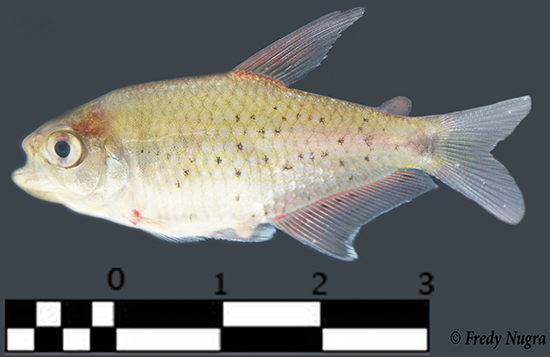| SOURCE FOR OCCURRENCE IN ECUADOR: Barriga (2012), Jimenez et al. (2015). |
| ORIGINAL DESCRIPTION: Gery, J. 1972. Remarques sur quelques poissons characoides de la Colombie et de l'Equateur, avec la description d'une nouvelle espece de Pseudochalceus. Revue Suisse de Zoologie v. 79 (pt 2, no. 31): 931-945. |
| TYPE SPECIMENS: Holotype: MHNG 1226.90, paratypes: ANSP 140067. Other museum lots: FMNH-80416, FMNH-80417, CEMZ-p-306, 336, 348, 393 (Jimenez-Prado et al., 2015). |
| TAXONOMIC STATUS: Considered valid (Eschmeyer and Fricke, 2019) but may need taxonomic revision to properly distinguish it from P. bohlkei. Gery described P. longianalis in 1972 but did not contrast it with P. bohlkei, which was described by Orces in an Ecuadorian journal in 1967. The two species are extremely similar in their morphology including their distinctive color pattern. It is possible that Gery was not aware of Orces' description of P. bohlkei since he did not cite Orces, so these two species may possibly be synonyms. However, they are considered valid and should continue to be considered valid until a proper taxonomic revision is conducted. |
| RANGE ECUADOR: Northwestern Ecuador in Esmeraldas province. Jimenez-Prado et al. (2015) report collections from tributaries to the Cavachi, Bogota, and Wimbicito rivers in the Santiago-Cayapas drainage basin of Esmeraldas province. |
| RANGE OUTSIDE OF ECUADOR: Southern Colombia (Lima et al., 2003; Maldonado-Ocampo, 2012). The type locality is in Colombia on the border with Ecuador in the Guiza River, a tributary of the Mira River, 1 27'N, 78 27'W, 240m ASL (Lima et al., 2003). |
| COLLECTIONS IN ECUADOR: See TYPE SPECIMENS above for holotypes, paratypes and a few other museum lots. |
| MAXIMUM SIZE: 78.5 mm SL (Lima et al., 2003). |
| DISTINGUISHING FEATURES: Pseudochalceus is quite a distinctive characid genus not easily confused with other characid genera in western Ecuador. It can be distinguished from other small tetras occurring in western Ecuador by its relatively deep and short body, large mouth, and distinctive coloration, with small spots or long horizontal lines along the body depending on the species. Pseudochalceus longianalis can be distinguished from the other common species in the genus, P. lineatus because it has long dorsal, pelvic, and anal fin rays, and a longer anal fin base than P. lineatus. It also has a spotted coloration while P. lineatus has long horizontal lines along its flanks. It is not clear how P. longianalis can be distinguished from P. bohlkei since these two species have not been compared morphologically and their descriptions are quite similar. See the TAXONOMIC STATUS section above for more details. |
| ECOLOGY: There is very little information on the ecology of this species. Jimenez-Prado et al. (2015) report it as occurring in small to medium sized rivers with gravel or rock bottoms and clean flowing water. They also indicate that it is considered an indicator species for good water quality. |
| ECONOMIC IMPORTANCE: Not of importance as a food species because of its small size. May have potential as an aquarium species because of its attractive color pattern, long fins, and small size. |
| CONSERVATION STATUS: Unknown, although it may be threatened by mining activities that can be quite destructive in rivers of Esmeraldas province (Jimenez-Prado et al., 2015). |
| LINK TO FISHBASE PAGE: https://www.fishbase.in/summary/Pseudochalceus-longianalis.html. |
| SPECIES PROFILE CREATED BY: Windsor Aguirre |
| SPECIES PROFILE CONTRIBUTORS: Fredy Nugra |
